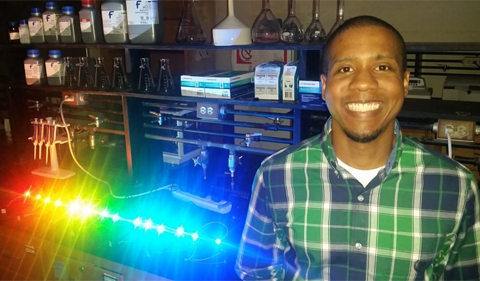Dr. Travis A. White, Assistant Professor of Chemistry & Biochemistry, recently presented an invited talk titled “Moving electrons and protons with visible light-absorbing heteroleptic Cu(I) photosensitizers” at the 255th American Chemical Society National Meeting & Exposition in New Orleans on March 21.
The symposium program, “PCET PhotoCatalysis with Inorganic Materials and Molecules,” included top researchers in the fields of proton-coupled electron transfer and photocatalysis.
This presentation highlighted the recently published work (Inorganic Chemistry 2018, 57, 2865) from White’s research group involving the production of hydrogen fuel using water, light, and molecular photocatalysts.
While at the conference, White also served as a chair and moderator for one of the symposium’s sessions.
For more information regarding photocatalytic water reduction to hydrogen fuel, contact White at whitet2@ohio.edu.
Abstract for “Moving electrons and protons with visible light-absorbing heteroleptic Cu(I) photosensitizers”: Storing solar energy in the form of chemical bonds (i.e. solar fuels) is an attractive approach towards the pursuit of renewable and storable energy sources. In the presence of sunlight, plants achieve this solar-to-chemical energy process through proton-coupled electron transfer (PCET) events to rapidly shuttle electrons and protons from H2O to CO2, ultimately forming sugars. By coupling the two transfer events, kinetically sluggish reactions with high-energy intermediates are avoided. In an effort to better understand and mimic Nature’s processes, chemists are able to design and modify synthetic analogues to provide potential structure-activity relationships. Our current research involves the development of heteroleptic, visible light-absorbing Cu(I) photosensitizers (PS) for applications in solar fuels production, specifically proton reduction to hydrogen gas. The Cu(I) PS of the design [(PP)Cu(R2-biq)]PF6 (PP = bidentate diphosphine ligand; R2-biq = substituted 2,2′-biquinoline ligand) are capable of visible light absorption beyond 550 nm to populate emissive charge transfer excited states with lifetimes up to one microsecond. Preliminary results have indicated that, in the presence of a sacrificial electron donor and protons, photoexcitation of the Cu(I) PS transfers reducing equivalents to bis-polypyridyl Rh(III) water reduction catalysts (WRC), resulting in subsequent hydrogen evolution. The identity of the ligands on the Cu(I) PS and Rh(III) WRC strongly impacts the catalytic activity by varying the driving force for intermolecular electron transfer. The redox, photophysical, and photocatalytic properties of the Cu(I) PS and Rh(III) WRC as well as efforts towards driving PCET with this PS/WRC system are presented herein.




















Comments